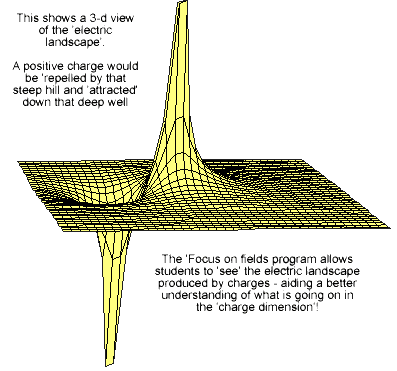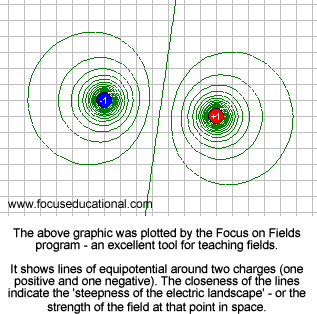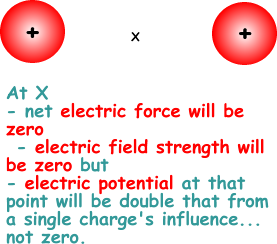    |
|||||||||||

Electric/Electrostatic Potential |
|||||||||||
|
Electric (or electrostatic) potential can be defined as the work done in bringing unit positive charge from infinity to that point in the field - it is also defined as the potential energy per unit of charge associated with a static (time-invariant) electric field It is measured in volts (V) . It is a scalar quantity. The difference of electrical potential between two points is known as potential difference or voltage. You are used to living in the matter dimension - one in which objects 'gravitate' towards or away from a point because of the gradient of the landscape around them. A stationary ball will always roll downhill if placed on a sloping surface and remain stationary on a level surface. Think of an 'electric dimension'. One where charges create the lanscape that all charged objects react to. Look at the above definition of electric potential and think of it in terms of graviational potential. We could say that gravitational potential (position in the gravitational field) is the potential energy per unit of weight associated with a gravitational field - the two are comparable
Electric potential is a scalar value. This gives people problems because it has a sign (positive or negative). You need to think of the sign as an indication of whether that point in space is above or below the zero plane. To work out the potential of a point affected by the fields of several charges you need to work out what effect each charge has on the height of the 'terrain' at that point. A positive charge will lift it above zero and a negative charge below zero. You simply add the 'adjustments in electric height' together to get the final value.
What is the electrostatic potential at point X? using the equation:
work out the potential at X from each of the charges. The result from the positive charge is 1.12 x 104 volts (point X is lifted by the presence of that charge) and from the negative charge it is -1.12 x 104 volts (point X is lowered by the presence of that charge). The sum of these is zero volt potential (X is at zero potential - the same level as it would be if no charges were present at all!). A multiple choice question caused a lot of anxiety a couple of years ago. It was a true/false type and the statement that many thought was true was: "Electric potential is zero whenever the electric field strength is zero" This is a FALSE statement, but many students couldn't see it was false.
The positive charges both push a positive test charge with equal force cancelling out the acceleration effect. The electric field strength at that point is therefore zero BUT both charges have an effect on the electric potential of point X. The presence of one of them makes it harder to bring unit positive charge from infinity but the presence of the second one makes it twice as hard!. It is as if that point in 'electric space' is raised twice as high by the second charges presence. You can think of electric potential as "pressure" in the following analogy: if two people push on a balloon, one on each side,with equal force the total force will be zero - no net force - but the pressure in the balloon is higher than with true zero force being applied. |
|||||||||||
 |
|||||||||||



 You can plot points of equipotential around a charge to get a 'contour map' of that electric landscape.
You can plot points of equipotential around a charge to get a 'contour map' of that electric landscape. Sample Question:
Sample Question:  Electric field strength or intensity is a vector - so if equal pulls or pushes act on the 'test particle' at the point in space you are looking at they will cancel each other out. BUT the potential at that point in space will be subject to the change in potential due to the influence of all charges in the locality. Look at the diagram.
Electric field strength or intensity is a vector - so if equal pulls or pushes act on the 'test particle' at the point in space you are looking at they will cancel each other out. BUT the potential at that point in space will be subject to the change in potential due to the influence of all charges in the locality. Look at the diagram. 
